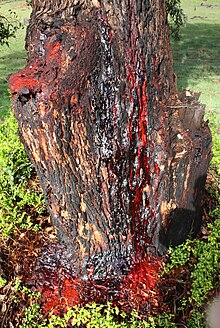

Kino is a botanical gum produced by various trees and other plants, particularly bloodwood species of eucalypts (Angophora, Corymbia, Eucalyptus) and Pterocarpus, in reaction to mechanical damage,[1] and which can be tapped by incisions made in the trunk or stalk. Many Eucalyptus, Angophora and Corymbia species are commonly referred to as 'bloodwoods', as the kino usually oozes out a very dark red colour. Kino flow in angiosperms contrasts with resin flow in conifers.[2][3] The word kino is of Indian origin.[4] In Australia, "red gum" is a term for kino from bloodwood trees and red acaroid resin from Xanthorrhoea spp.
- ^ A Critical Revision of the Genus Eucalyptus
- ^ Paolo Cabrita (2019). "Holocrine Secretion and Kino Flow in Angiosperms: Their Role and Physiological Advantages in Plant Defence Mechanisms". arXiv:1902.09308.
{{cite journal}}: Cite journal requires|journal=(help) - ^ Cabrita, Paulo (2019), Ramawat, Kishan Gopal; Ekiert, Halina Maria; Goyal, Shaily (eds.), "A Model for Resin Flow", Plant Cell and Tissue Differentiation and Secondary Metabolites, Reference Series in Phytochemistry, Cham: Springer International Publishing, pp. 1–28, doi:10.1007/978-3-030-11253-0_5-1, ISBN 978-3-030-11253-0, S2CID 213433682, retrieved 2020-12-06
- ^ Hillis W.E.: Heartwood and Tree Exudates. Springer, 1987, ISBN 978-3-642-72536-4 (Reprint), p. 44 f, 50 f.